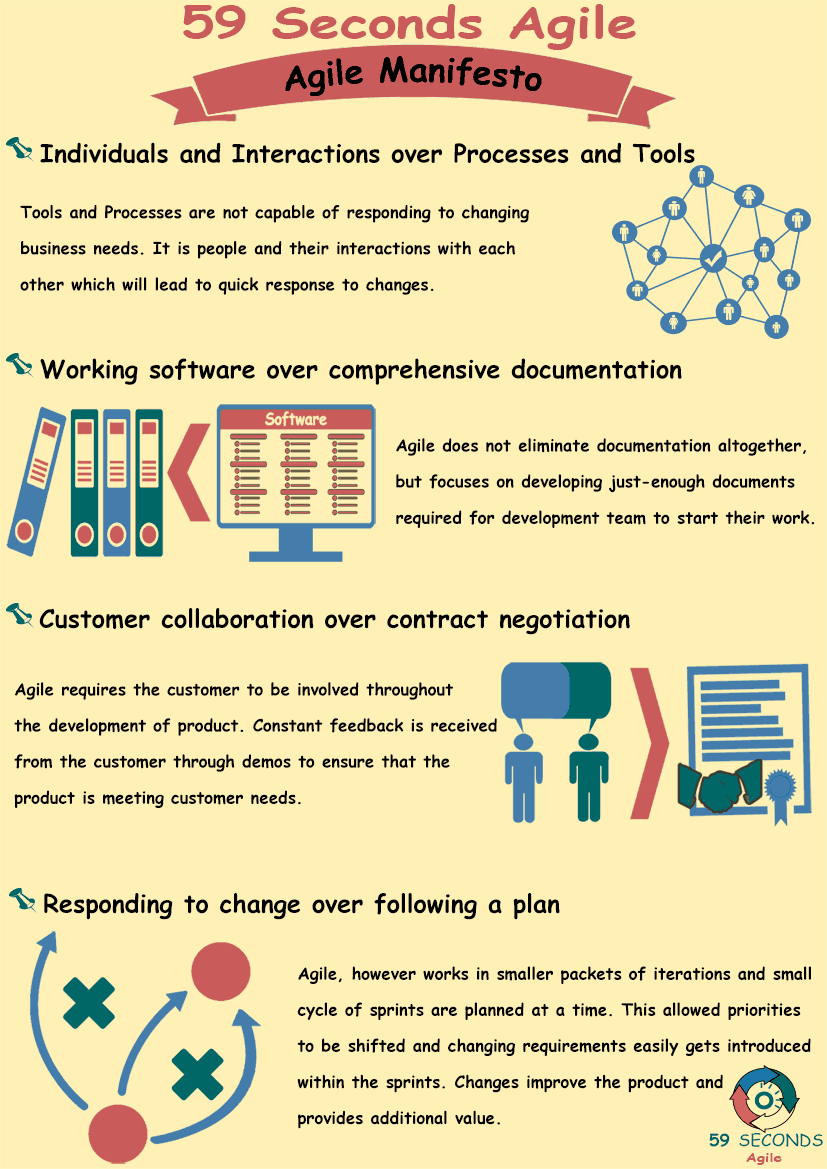What is the Agile Development Manifesto and how does it assist development teams in delivering maximum product value?
The Agile Manifesto
A 59 Seconds Agile Video Animation
The Agile Development Manifesto for Developers
A 59 Seconds Agile Article
In Agile software development, the Agile Development Manifesto is the most important piece of documentation. It is the backbone for every tenet of Agile. While very short, it contains the core goals of a team seeking to follow Agile methods. The four main points give the priorities of an Agile team.
1. Individuals and interactions over processes and tools
2. Working software over comprehensive documentation
3. Customer collaboration over contract negotiation
4. Responding to change over following a plan


While these goals are given for the entire team, they each have a specific meaning to the developer role. Developers are the driving force behind creating new software. They are vital members to the Scrum team, and need to work as efficiently as possible. When developers follow these core beliefs, they can create software in a way that benefits the entire Scrum team.
Agile Development Manifesto: Individuals and Interactions
The first component of the Agile Manifesto, individuals, and interactions may seem abstract in the technology field. Software development is known for being rigid and logical, and the concepts of individuals and interactions seem unrelated at first glance. However, prioritizing individuals and interactions over processes and tools create a more cohesive and effective team.
In traditional software development, employees are like cogs in a machine. No one member stands out as unique, and everyone is considered replaceable. If one developer is unable to handle a task, it is given to another developer. With project management styles like Waterfall, the process is the most important factor. Developers follow instructions and work on any task that they receive.
Agile software development gives value to every team member. Developers choose which tasks to work on. Some developers may want to pick a feature that they are familiar with. Other developers may choose a smaller task on a feature that they wish to learn more about. Different developers have different skill sets, and it is important that they are able to work on tasks that they are comfortable with. Instead of sticking to a definite process, the process is molded around the individuals and how they interact. Tools are used by developers in the ways they see fit.
Agile Development Manifesto: Working Software
The ultimate goal of any software development project is a working product. However, some management styles prioritize documentation over the actual software. Features need to be fully planned out before they even begin production. In Agile, documentation is kept to a bare minimum, and the Scrum team can focus on creating working software.
Older methods of software development require developers to match the specifications for a product. This means that developers are limited by the original plans for a feature. If they come up with an idea during development that would improve the product, it may not be possible to get the documentation changed. Even if the new method would be superior, it wouldn’t be what the team planned for the feature. Unfortunately, teams often learn more about a feature as they work on it. Making plans at the very beginning may leave them with documentation that isn’t ideal for the planned feature.
With Agile placing emphasis on working software, the methods and documentation matter less. There are multiple benefits to this. Most importantly, it allows developers to work toward the most efficient way to design a feature. Not only does it create a better product, but it removes unnecessary documentation. Instead of looking through pages and pages of specifications, documentation is kept to what is absolutely required. This means that Scrum team members can spend less time reading about a feature, and more time working on it.
Prev <— Continue Reading —> Next
User Stories Applied
A 59 Seconds Agile Book Review
User Stories Applied by Mike Cohn is one of our favourite books on Agile User Stories. The book starts with an overview into user stories, and details what a user story is and the different aspects of them. He then discusses how to go about writing a user story, and provides details of the INVEST criteria that can be used to determine if the story is meeting all of its objectives. Next Mike gives an in depth discussion of who user stories are written for and where to begin when gathering the details for them. The book then discusses acceptance testing user stories, including how to go about specifying these criteria and the responsibilities of the development team and customers during this process.
Prev <— Continue Reading —> Next
Learn More
Agile Project Management Training Courses
The Agile Manifesto
A 59 Seconds Agile Infographic

Prev <— Continue Reading —> Next
Our Favourite Agile Books
We found these books great for finding out more information on Agile Scrum:
The ‘Agile Scrum Master Training Course With 59 Seconds Training‘ is now available for free. This free Scrum Master Certified Online Training Course provides an in-depth understanding of the Agile Scrum Master roles and responsibilities, where you find out what a Scrum Master does and how to do it. During this free course you will learn all of the tools needed to succeed as an Agile Scrum Master.
Thank you for choosing us to learn about the Agile Scrum Framework.




